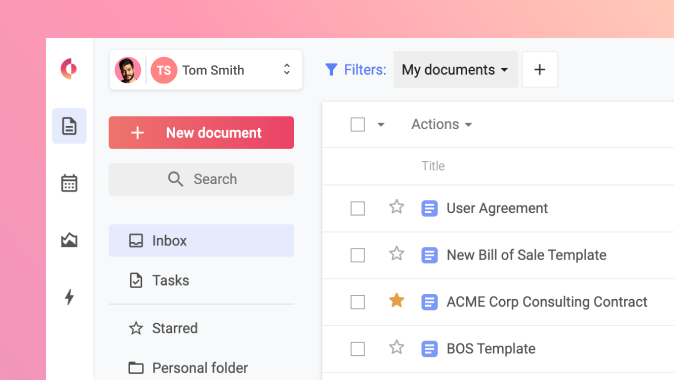Answering the 10 Most-Asked Contract Management Evaluation Questions
How do you know what is nice-to-have versus need-to-have? What are the key questions you should ask when researching contract management solutions?
Due diligence complete, you’ve scoped out your project, gathering all the information on what your current contract processes look like and the challenges you’re looking to solve. Now it’s time to evaluate solutions. Where do you begin? How do you know what is nice-to-have versus need-to-have? What are the key questions you should ask when researching contract management solutions? Let’s explore 10 of the most frequently asked questions when considering a contract management solution.
How long does implementation take?
This is a loaded question with a variety of answers. In short, implementation can take anywhere from days to more than a year, depending on the type of solution purchased. A good rule of thumb to follow is the more customization of a product, the longer the implementation time. An industry benchmark for implementation of a contract management solution is 200 users in two weeks, fully up-and-running. Implementation and training should be free, included in the overall quoted price. Asking questions about each of these points will help you address the question of implementation timeline and what is acceptable for your use case.
Lastly, when discussing implementation time, ask about maintenance fees. Are there any? When do they go into effect? Maintenance fees should be included in the overall price tag, but this point is necessary to clarify prior to engagement to avoid surprises down the line.
What happens with our legacy contracts?
Ideally, you will be able to upload legacy contracts into the new platform. This lends itself to the other goals associated with having a single-source-of-truth. Many providers will handle the migration of your old contracts for you. Make sure to ask: 1. if this type of upload or central repository exists, 2. if there is a fee associated with this, and 3. whether the contract metadata can be migrated as well.
Which integrations are available?
This is a two-part question. The first question to ask is which integrations come “out of the box.” Beware: not all integrations are equal, meaning that some are more thorough and allow for more functionality. People should ensure the integrations offered meet their needs. If you’ve mapped your contract process throughout the organization, this will help you understand the integration points between software and what you will need to look for. The second question is whether the new solution has an open API. An open API allows software to connect with any other software by building an integration. Ultimately, you may want a solution with an open API, so your IT team can create custom integrations that work for your purposes.
How should we structure our team to use it?
First, determine what your use case is (legal, procurement, sales, corporate, etc.). Then, think about how your team processes contracts now and who needs access to them. After sketching that out, determine who really needs to be an admin and therefore have full access to the info in the contracts. Doing this analysis before coming to the table not only helps you understand more fully your processes and needs, but it can also help the vendor successfully map out a solution that will best fit your needs.
What level of customization can I expect?
What’s important to you when it comes to customization? Inboxes, dashboards, documents, processes? What are you looking to achieve? Is it really customization you’re looking for, or is it flexibility within a solution to adapt to your needs and different contract types or use cases? These are great questions to address when starting the conversation around needs and what a solution can provide.
To harken back to the implementation conversation, over-customization increases implementation time, but it can actually make for a less-efficient process. Many times, a simple, intuitive interface can actually encourage sustained adoption by your team members, even in other departments.
What is the 3rd party experience?
Invited third-party guests, whether they are invited to sign or negotiate a contract, should be able to access contracts in the system without creating an account or paying any type of fee. After addressing the monetary conversation, inquire about how these third-parties are invited to sign, negotiate or collaborate on a document. Does negotiation still require emailing a document back-and-forth? Will you need to work in Word or PDF, or can you negotiate online within the solution? Will all the changes, comments, redlines, etc. be automatically tracked? Is the signature secured using a secondary solution to the contract management solution? Will you have to pay for that additional e-signature solution outside of the costs of the contract management solution? As an invited third-party, you should not incur hidden fees for this basic functionality. Understanding the experience and functionality from a third-party perspective will help you gain adoption from those third-parties and have a more comprehensive understanding of how the solution fits into your process flow.
How can we set up who approves contracts?
A solution should incorporate users’ permissions and roles that empower you to set up admins, teams, etc. according to your processes. It should also include approval workflows, at a minimum at the document level but ideally at the company level, where you can create a workflow for a type of document or process and include it on any contract or document created. This type of company-level workflow enables you to easily make changes if, say, someone leaves or a process changes. Take an inventory of your current contract processes so you have a clear understanding of your workflows before even using a contract management solution, and investigate different levels of editing and access permissions available. Lastly, understand how subsidiary management works with each solution you’re evaluating—can you do it (you should be able to), how is it structured, and what do those user access and permission rights look like.
Where is the data located; how is it backed up?
There is a large conversation that can be had around data, too big to adequately address completely. However, one of the biggest areas of concerns is around data-locality, which is going to be largely based on your needs and security requirements. When it comes to where data is stored, there are basically two options: the Cloud or on-premise.
A cloud-based system has advantages over on-premise in terms of ease of maintenance, accessibility, and in many cases security. When it comes to security and data conversation it’s helpful to loop in your IT team early to get a firm understanding of the system and security requirements to look for when evaluating. Additionally, if evaluating a Cloud solution, ask what servers or platform they’re using, AWS, MS, Azure, etc. Sometimes considered the ghost at the table, a third-party platform such as one of these services can affect security and is a consideration for mitigating risk, liability and indemnity concerns (note: when contacting contract management vendors ask for their security information – they should have a security review sheet available and ready to share).
How can we track and use metadata?
Have the vendor take you through what it looks like to upload existing contracts and then to access that legacy information. Metadata, the critical data in your contracts, can be used in a multitude of ways and having a clean, clear way to track and report on it is essential. Make sure you have an option to notate and track metadata within the product, as well as export it. Exporting data empowers additional reporting capabilities, especially when it comes to manipulating data and creating robust reporting for the C-suite. At Concord, we use a feature called the Summary Sheet—a side panel that exists on every contract that allows you to enter and track dates, clauses, business-critical fields and tags. This information can then be pulled into reporting to grant visibility into your processes and overall contract corpus.
How will we grow with this solution?
A key to evaluating software is to not only consider current challenges and processes, but to also evaluate growth and how the system will accommodate future needs. How adaptable is the solution? To address future needs, choose a solution that is flexible, that can be used across multiple use-cases, and departments across the organization. A contract management platform should be flexible, adaptable and scalable, easily changing with you as business needs change. Lastly, consider storage limitations—how many documents can the system host? A solution should allow unlimited documents so it never limits you, how you do business or caps your growth.
This article originally appeared on ITProPortal.



